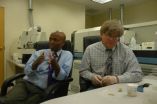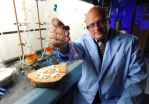(Press-News.org) Eastern Asia, Western Asia, Japan, Beringia and even Europe have all been suggested origination points for the earliest humans to enter the Americas because of apparent differences in cranial form between today's Native Americans and the earliest known Paleoamerican skeletons. Now an international team of researchers has identified a nearly complete Paleoamerican skeleton with Native American DNA that dates close to the time that people first entered the New World.
"Individuals from 9,000 or more years ago have morphological attributes -- physical form and structure -- distinctive from later Native American peoples," said Douglas Kennett, professor of environmental archaeology, Penn State. "What we have here is the unique combination of an adolescent Paleoamerican skeleton with a Native American DNA haplotype."
The skeleton of a teenage girl was found in Hoyo Negro, a deeply submerged chamber in the Sac Actun cave system in the eastern Yucatan Peninsula, Mexico. Alberto Nava Blank and a team of science divers discovered the skeleton along with many extinct animal remains deep inside this inundated cave in 2007. The divers named the girl Naia. The Hoyo Negro project is led by Pilar Luna and the Instituto Nacional de Antropología e Historia of Mexico, Nava and James Chatters, owner of Applied Paleoscience, with funding from the National Geographic Society.
This collaborative interdisciplinary research effort is reported in today's (May 16) issue of Science.
Kennett and Brendan J. Culleton, postdoctoral fellow in anthropology, Penn State, were originally asked to directly date the skeleton. After traditional and well accepted direct-dating methods failed because the bones were mineralized from long emersion in warm salty water within this limestone cave system, they worked closely with colleagues to build a geochronological framework for Naia using a unique combination of techniques to constrain the age of the skeleton to the end of the ice age.
To build the case for a late Pleistocene age they collaborated with Yemane Asmerom and Victor Polyak from the University of New Mexico using global sea level rise data to determine when the cave system, which at the time Naia and the extinct animals entered was dry, filled with water. The site where Naia lies is now 130 feet below sea level and sea level rise would have raised the groundwater level in the cave system and submerged everything between 9,700 and 10,200 years ago. So initial estimates of the latest that animals and humans could have walked into the cave system was 9,700 years ago.
At the same time, the researchers experimented with uranium thorium dating the skeleton directly. Asmerom and Polyak tried to directly date Naia's teeth using this method, but that also did not work well.
The bones were found deep below today's ground surface in a collapsed chamber connected to the surface via a web of now flooded tunnels that Naia once walked along to fall to her untimely death. Because the caves are limestone, mineral deposits continued to form while the cave was largely dry. Working with Patricia Beddows, Northwestern University, Chatters noticed accumulations of calcium carbonate -- tiny rosettes of calcite deposited by water dripping off the cave roof -- which could be accurately dated using the uranium thorium method. Because these drip water deposits formed on top of Naia's bones, their date must occur after she fell in the cave. The oldest one dated so far is 12,000 years old.
Naia's tooth enamel was also radiocarbon dated to 12,900 years ago by Kennett's lab.
"Unfortunately, we can't rule out that the tooth enamel is contaminated with secondary carbonates from the cave system, but we removed potential contaminates using standard techniques and Tom Stafford, Stafford Research Laboratories, produced a comparable age," said Kennett. "We consider this a maximum age and when combined with the uranium thorium dates from the adhering speleothems, we argue that the skeleton dates between 12,000 and 13,000 years ago. Well placed as a Paleoamerican."
Morphologically, Naia does not look like a contemporary Native American, but mitochondrial DNA testing -- maternally inherited DNA -- carried out by Brian Kemp, Washington State University, and his collaborators shows that she has a D1 haplotype. This is consistent with the hypothesis that her ancestors' origins were in Beringia, a now partially submerged landmass including parts of Siberia, Alaska and the Yukon. Early humans moved into this area from elsewhere in Asia and remained there for quite some time. During that time they developed a unique haplotype that persists today in Native Americans. Genetically, Paleoamericans have similar attributes as modern Native Americans even if their morphology appears different.
"More work is needed," said Kennett. " There are still carbonate deposits on the bones of Naia and other animal bones in the cave. The Instituto Nacional de Antropología e Historia and the scientific diving community have nicely preserved the site so the next step will be to date additional samples to constrain the age of Naia and associated extinct animals further."
Also working on this project were Eduard Reinhardt, McMaster University, Ontario; Joaquin Arroyo-Cabrales, INAH; Deborah A. Bolnick, University of Texas at Austin; Ripan S. Malhi, University of Illinois; Dominique Rissolo, Waitt Institute; and Shanti Morell-Hart, Stanford University.
INFORMATION:
The National Geographic Society, Archaeological Institute of America, Waitt Institute, Instituto Nacional de Antropología e Historia and the National Science Foundation supported this work. Penn State, the University of New Mexico, the University of Texas at Austin and DirectAMS also supported this project.
Dating and DNA show Paleoamerican-Native American connection
2014-05-15
ELSE PRESS RELEASES FROM THIS DATE:
Genetic study confirms link between earliest Americans and modern Native-Americans
2014-05-15
AUSTIN, Texas — The ancient remains of a teenage girl found in an underwater Mexican cave establish a definitive link between the earliest Americans and modern Native Americans, according to a new study released today in the journal Science.
The study was conducted by an international team of researchers from 13 institutions, including Deborah Bolnick, assistant professor of anthropology at The University of Texas at Austin, who analyzed DNA from the remains simultaneously with independent researchers at Washington State University and the University of Illinois at Urbana-Champaign.
The ...
First 'heavy mouse' leads to first lab-grown tissue mapped from atomic life
2014-05-15
Scientists have created a 'heavy' mouse, the world's first animal enriched with heavy but non-radioactive isotopes - enabling them to capture in unprecedented detail the molecular structure of natural tissue by reading the magnetism inherent in the isotopes.
This data has been used to grow biological tissue in the lab practically identical to native tissue, which can be manipulated and analysed in ways impossible for natural samples. Researchers say the approach has huge potential for scientific and medical breakthroughs: lab-grown tissue could be used to replace heart ...
One of oldest human skeletons in North America is discovered
2014-05-15
Cave-diving scientist Patricia A. Beddows of Northwestern University is a member of an international team of researchers and cave divers this week announcing the discovery in an underwater Yucatán Peninsula cave of one of the oldest human skeletons found in North America.
Details of "Naia," a teenage girl who went underground to seek water and fell to her death in a large pit named Hoyo Negro ("black hole" in Spanish), will be published May 16 in the journal Science.
"The preservation of all the bones in this deep water-filled cave is amazing -- the bones are beautifully ...
Communicating with the world across the border
2014-05-15
Stanford, CA—All living cells are held together by membranes, which provide a barrier to the transport of nutrients. They are also the communication platform connecting the outside world to the cell’s interior control centers. Thousands of proteins reside in these cell membranes and control the flow of select chemicals, which move across the barrier and mediate the flux of nutrients and information. Almost all of these pathways work by protein handshakes--one protein “talking” to another in order to, for example, encourage the import of a needed nutrient, to block a compound ...
Quantum simulator gives clues about magnetism
2014-05-15
Assembling the puzzles of quantum materials is, in some ways, like dipping a wire hanger into a vat of soapy water, says CIFAR (Canadian Institute for Advanced Research) Fellow Joseph Thywissen (University of Toronto).
Long before mathematical equations could explain the shapes and angles in the soap foams, mathematicians conjectured that soap films naturally found the geometry that minimized surface area, thus solving the problem of minimal surfaces. They could be created simply by blowing soap bubbles.
At the University of Toronto's Ultracold Atoms Lab, Thywissen ...
UNM plays major role in establishing link between ancient and modern Native-Americans
2014-05-15
Her name is Naia, and for thousands and thousands of years, the skeleton of this young woman was buried underwater in an elaborate cave system in the Yucatan Peninsula after she had apparently fallen into what was then a dry deep pit.
Now, a team of researchers, including Professor Yemane Asmerom and Research Scientist Victor Polyak at the University of New Mexico's Department of Earth and Planetary Sciences, have accurately determined the age of the oldest-known, well-preserved human skeleton. Naia was one of the earliest inhabitants of the Americas and has helped resolve ...
Making money from lignin: Roadmap shows how to improve lignocellulosic biofuel biorefining
2014-05-15
When making cellulosic ethanol from plants, one problem is what to do with a woody agricultural waste product called lignin. The old adage in the pulp industry has been that one can make anything from lignin except money.
A new review article in the journal Science points the way toward a future where lignin is transformed from a waste product into valuable materials such as low-cost carbon fiber for cars or bio-based plastics. Using lignin in this way would create new markets for the forest products industry and make ethanol-to-fuel conversion more cost-effective.
"We've ...
UH researchers find definitive evidence of how zeolites grow
2014-05-15
Researchers have found the first definitive evidence of how silicalite-1 (MFI type) zeolites grow, showing that growth is a concerted process involving both the attachment of nanoparticles and the addition of molecules.
Both processes appear to happen simultaneously, said Jeffrey Rimer, an engineering professor at the University of Houston and lead author of a paper published Thursday in the journal Science.
He said a second component to the research could have even more lasting impact. He and researcher Alexandra I. Lupulescu used a new technique allowing them to view ...
Anti-craving drug and counseling lower alcohol harm in homeless, without sobriety demands
2014-05-15
Chronically homeless, alcohol-dependent individuals might benefit from a new intervention that does not require them to stop or even reduce drinking, according to the results of a preliminary study in Seattle.
Participants in the 12-week pilot program received monthly injections of an anti-craving medication, extended-release naltrexone. They also met regularly with study physicians to set their own goals for treatment and to learn to be safer in their use of alcohol.
"Abstinence-based alcohol treatment has not been effective for or desirable to many homeless people ...
UTHealth research: Children of parents in technical jobs at higher risk for autism
2014-05-15
HOUSTON – (May 15, 2014) – Children of fathers who are in technical occupations are more likely to have an autism spectrum disorder, according to researchers at The University of Texas Health Science Center at Houston (UTHealth).
The findings will be presented Friday at the International Meeting for Autism Research in Atlanta.
During participation in the LoneStar LEND program, first author Aisha S. Dickerson, Ph.D., a researcher at UTHealth's Center for Clinical and Translational Sciences, used the United States government's Standard Occupational Classification system. ...







